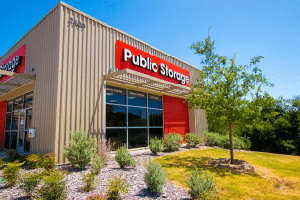As Managing Director of Storage for SkyView Advisors, I was recently invited to speak at Evercore’s Storage Conference which featured market leaders speaking on Transactions, Operations, Acquisitions, Development and from a Public REIT / CEO perspective. Many of the top operators and third party industry leaders were in attendance. I was humbled to be on the panel and part of the event among the leaders of our industry. After reflecting on the conference as well as recent transactions, I am sharing my initial thoughts as we gear up for the 2024 Storage Market.
I’ll start by stating the obvious: 2023 transaction volume is down in Storage and across commercial real estate. With rising interest rates, there is a bid / ask spread in which expectations are being adjusted. Financing deals are now bleeding into the low 7s, so cap rates are moving up to enable yields that exceed debt cost.
Beyond rising cap rates, there are second order effects of the rise of interest rates. Specifically, this has created a difficult environment for regional banks and even some larger banks have exposure to CRE. And while the poor performance of the professional office asset class has grabbed the headlines, there are downstream effects in inhibiting some banks ability to lend across real estate and/or reducing risk tolerance, which creates a dilemma and headwinds to issue new lending even in categories such as Storage, which have held up relatively well.
So what is the set up for 2024 and what are the emerging trends? The first 3 trends below hint at a Buyers market in which Buyers can be more selective and rigorous in their evaluation. The second 4 trends are market factors that Sellers and deal makers can hone in on to partially offset Buyer concerns.
1. Fully stable properties in larger, steadier markets holding up strongest.
Money is most attracted to fully stable properties, with a 100+ basis point premium for early lease up and 200+ basis point premium for CofO properties. Unlevered IRR on Class A / fully stable properties is trending at 7 to 8% with a swing up in secondary markets at 8 to 12% and in tertiary markets at 12 to 16%. Cities with high demand and high cost of living have held up relatively well, especially those that have been steadier during the recent boom. New York City, Southern California and Nashville are holding strong, while some of the high flyer markets such as Austin, Atlanta and Philadelphia have fallen off sharply.
2. Buyers have cautious to negative sentiment.
For the near-term to medium-term, there is an expectation of 0 to 3% NOI growth (lower than 3% in a normal market). There is a perception that the housing slowdown across the country portends to weaker demand while there is also concern that inflation and rising expenses can put pressure on the consumer whether rising property taxes, energy costs, insurance costs, student loan payments, etc. This means that Seller projections need to be built with reasonable expectations of growth, and not overly optimistic. Simply put, Buyers are being more rigorous with pro formas as they want projections that factor in current market conditions and have a likelihood of being achieved.
3. Buyers are looking for motivated Sellers.
Buyers are increasingly asking the Seller’s motivation (some might say this is a Buyers number 1 question). They want to know if there is a motivated seller so that there is a greater likelihood of getting to terms and through the deal process.
4. Inventory is low and Buyer demand exists if you go deeper.
As with other real estate segments, inventory is relatively low in the Storage category, and Buyers complain that there isn’t enough quality inventory. While some Buyer demand is receding and bank lending may be tighter, there are new and growing sources of market demand. The most aggressive buyers in the market are groups that are accessing foreign capital through family offices and sovereign funds. These are all cash buyers that are getting good deals. In comparison to other Buyer pools, foreign capital is pouring into the Storage space. Another large buyer of Storage is life insurance and other large institutions. They may have CRE goals that were previously weighted towards office, retail and/or multi-family. With nearly 1 billion sq ft of office space empty in the US, these institutions are looking to diversify and in many cases have little to no self-storage.
5. In place rents and management value-add partially counter negative street rates.
It’s not all doom and gloom when it comes to negative street rate growth. As always, some deals provide good management value-add opportunities in which the Buyer can plan on some CapEx to raise up the level of the property and charge higher rates. Further, the market is currently raising in place rents without much resistance. Some tenants may insist they will move out and negotiate rates down, but the move-out rate has not spiked, so owners are pushing the lever of increasing in place rents to get NOI stability or even growth.
6. Concerns of future supply may be overstated.
Developers believe that the majority of planned and proposed development may not move forward, or will be substantially delayed. When looking at proposed developments in a market, if there are concerns of future supply, you can contact the local municipality for the latest information on whether plans are stalled or delayed.
7. Certificate of Occupancy Stage (CofO) garnering interest.
As owners and developers get to the Certificate of Occupancy stage, they often have a scenario of rosy projections made during the boom and future conversion of financing as construction loans mature. Plus, they may see some headwinds with insurance premiums, labor costs and energy costs which have been increasing while they were building. This sets the stage for entertaining interest upon achieving Certificate of Occupancy in which Developers may have an incentive to accept a small profit and move on. Likewise, there are developers out there who have budget they are looking to put to work in development. They may be hesitant to start a new long-term development project given market conditions. The shortcut of getting a property at the CofO stage can be attractive, particularly in areas with low supply and good demographics, especially if they can secure with reasonable market pricing.
In today’s market it is imperative that owners contemplating a sale or simply seeking to understand the complex Storage landscape have an advantage. SkyView Advisors has the experience and expertise to provide that advantage. Our objective is to provide uncompromising personal service to every client, every time. Our goal is total reliability and producing the optimal results in every transaction.


